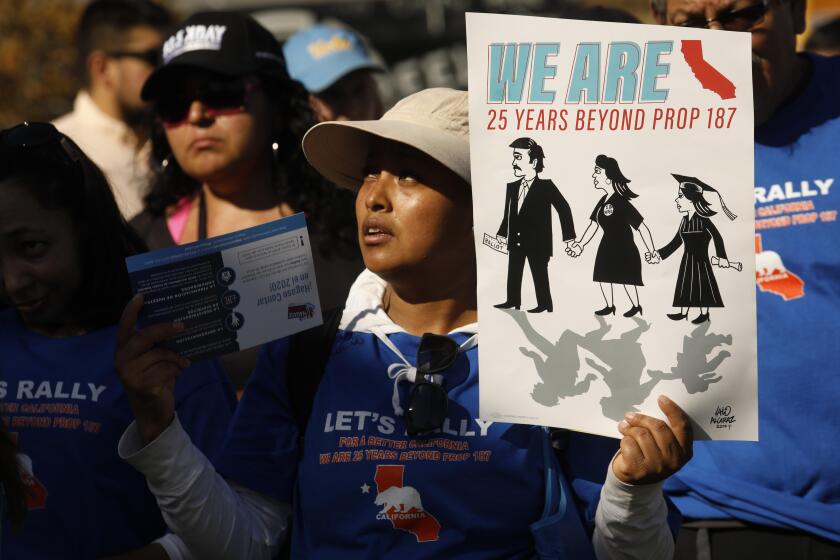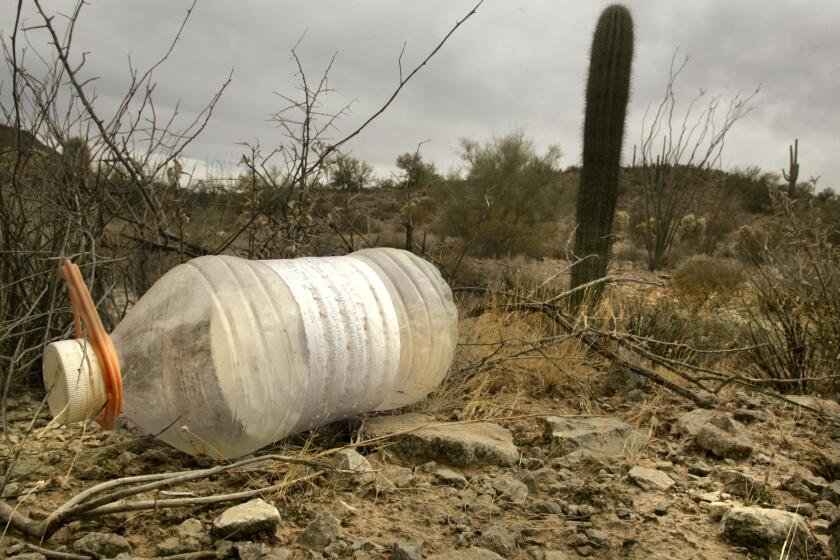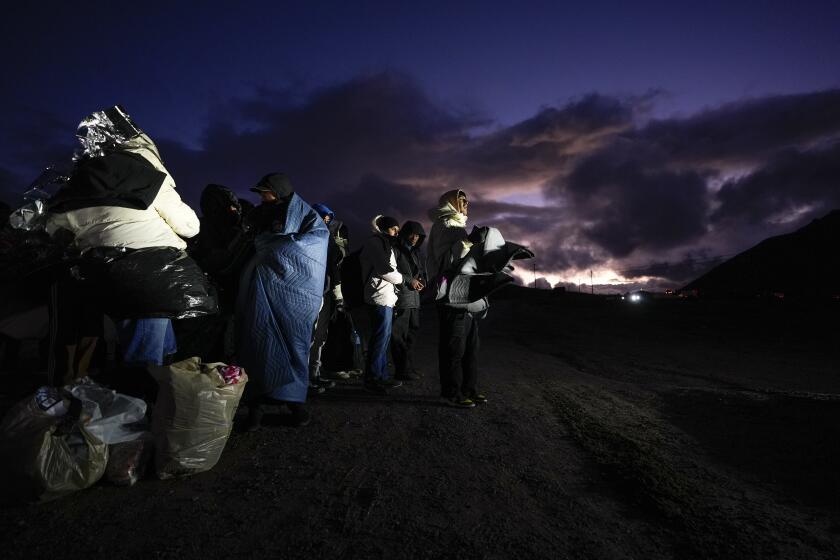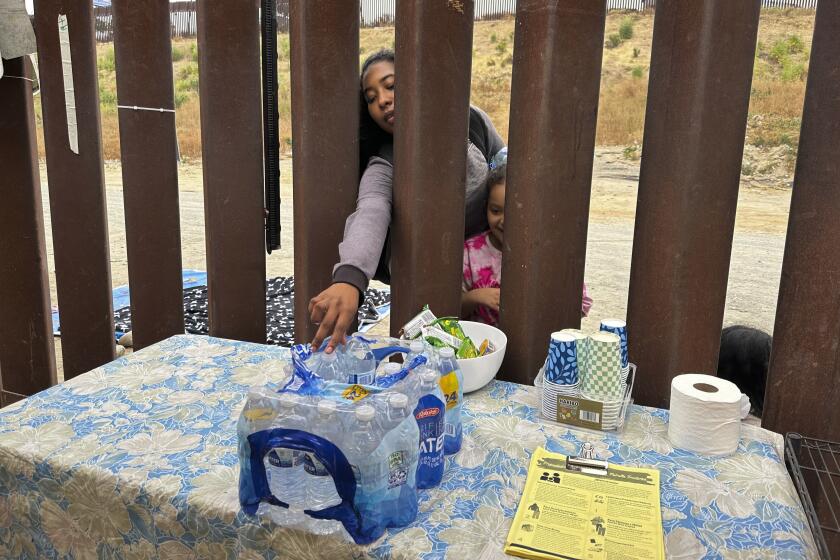Opinion: Trump and other Republicans call Kamala Harris a failed ‘border czar.’ Here’s the truth

- Share via
Donald Trump, JD Vance and other Republicans incessantly disparage Democratic presidential nominee Kamala Harris as the Biden administration’s “failed border czar.” That seriously distorts and shortchanges both the immigration policy she pursued and her record in implementing it.
“Border czar” is a gross mischaracterization of Harris’ role in the administration’s immigration policymaking. She was never tasked with fixing border enforcement.
Democrats and Kamala Harris should lean into her campaign slogan when it comes to ‘border security’ politics: ‘We won’t go back’ to demonizing immigrants.
In fact, her remit was to promote a different, complementary approach to controlling unwanted immigration: addressing why migrants felt it necessary to leave their homes.
Because so many migrants wish to be unseen, many humanitarian border issues are easily ignored. But mass suffering is occurring.
Experts agree that attacking the factors driving international migration — poverty, joblessness, drug and gang violence, agricultural failures due to climate change, corruption and other rule-of-law challenges — is essential to reducing pressure on our southern border. Absent success on that front, tweaking U.S. border enforcement will never have a lasting impact.
But efforts to address the “root causes” of immigration must be undertaken within a realistic time frame. The drivers of migration have been intensifying for decades or even generations in the countries that produce most of the influx. It will take years — probably extending over several presidential terms — for a root-causes approach to achieve highly visible results.
So investments in addressing root causes aren’t a quick fix, but neglecting them entirely or until the border is “secure” — as Trump and other Republicans insist — only delays sustainable management of immigration. Harris helped lay the groundwork for longer-term solutions through intensive diplomacy with Latin American leaders and other interests.
Should migrants ‘get in line and wait their turn’? What if there is no line? What if we changed that?
This points to another requisite of the root-causes strategy: It can’t be implemented unilaterally. It requires often messy, difficult negotiations with other governments, civil society groups, development banks and multinational corporations.
Harris’ aptly named “Partnership for Central America,” launched in July 2021, was such an all-hands effort. It raised more than $5.2 billion in private-sector commitments for job-creating projects in immigration-producing countries. To pull this off, Harris had to maneuver around formidable impediments to effective governance in countries such as Honduras and Guatemala, where authoritarian presidents were deeply implicated in corruption and drug trafficking.
Harris’ first task was to persuade elected officials in the three “Northern Triangle” countries — Honduras, Guatemala and El Salvador — to get on board with U.S.-led development projects there. Then she had to persuade multinational corporations to finance job creation and bring civil society groups into these public-private partnerships. Diplomacy, fundraising and coalition-building were all necessary for success.
Addressing the causes of migration has another important and unavoidable limitation: It can’t be done on a global scale. The need for sustained diplomacy, coalition-building and corralling of private capital makes that impractical.
Elections in Europe and the U.S. are being driven by the issue. President Biden’s policies haven’t reassured those concerned about the border and lawlessness.
Harris’ geographic portfolio was limited to Mexico and the Northern Triangle. When she began working on the project, that small subset of countries accounted for most of the migrants arriving at the U.S.-Mexico border.
But as the COVID-19 pandemic abated, the migrants became much more diverse in their national origins. In 2021, dozens of countries — including China, India, Russia and much smaller countries such as Mauritania — began exporting large numbers of migrants. They streamed through Ecuador, Colombia and Panama’s Darién Gap. Millions more poured out of Venezuela due to economic collapse and political violence under Nicolás Maduro’s regime.
By the end of last year, more than half of the migrants arriving at the southern border came from places other than Mexico and the Northern Triangle countries. Suddenly, the challenges of managing migration had become much steeper. This was a sea change in global migration for which Harris was in no way responsible but that enormously complicated her task.
Even so, the vice president’s efforts to implement a narrowly focused root-causes strategy had tangible results. Migration from the Northern Triangle to the U.S. border in recent years has steadily declined even as the flow of Mexicans fleeing a surge of drug cartel violence has increased.
Harris deserves her share of credit for this. The Biden-Harris administration’s record on border enforcement is certainly mixed, but that should not distract from the progress made through Harris’ efforts to address the causes of immigration.
For too many in Latin America, staying home is the worst possible option. If that calculus is ever to change, investments like those championed by Harris must be made — and not treated as a political football.
Nor do mixed results on border enforcement excuse Congress’ abject failure to fix a badly broken immigration system that hasn’t been reformed since the 1990s. Inadequate pathways for legal immigration only encourage unauthorized migration regardless of the causes.
Wayne A. Cornelius is a distinguished professor of political science emeritus at UC San Diego and was the founding director of the university’s Mexican Migration Field Research Program.
More to Read
A cure for the common opinion
Get thought-provoking perspectives with our weekly newsletter.
You may occasionally receive promotional content from the Los Angeles Times.














